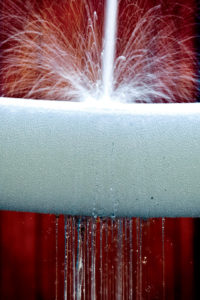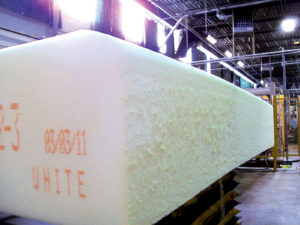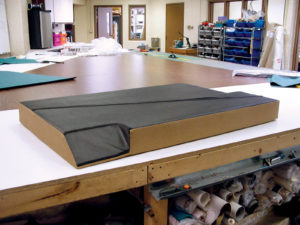The facts on foam

The drainable marine cushion foam from Wm. T. Burnett & Co. is a popular option for consistently wet marine applications.
Since the mid-20th century, foam has been used in marine applications to stiffen, strengthen and soften everything from seat cushions to headliners to beds. Knowing foam options, properties and applications of each type ensures marine fabricators are incorporating the best foam products into every project.
Foam is the inherent “undercover” element that makes boats, yachts and luxury liners the comfortable havens that their owners desire. Several different types of foam are available to the marine fabrication industry.
Conventional foam. Usually lower end, more economical, with many different weights and densities available. “Conventional foam is widely available, depending on density, and it is low to moderate priced,” says Bill Hughes, sales manager at Crest Foam Industries Inc. in Moonachie, N.J. “However there is no standard biocide for mold and mildew prevention.”
High Resilient (HR) foam. The basic difference between conventional foam and high resilient foam is the chemicals used to make the foam. High resilient foam uses higher-quality chemicals, which give it more resiliency and longer life. HR foam is more limited to higher-end weights, but many densities are available. “Sometimes high resilient foam can be difficult to find,” Hughes says. “It is high priced, but offers high comfort.” There is no standard biocide treatment to HR foam.
Cindy Boersema, owner of The Nautical Needle in Holland, Mich., explains that HR foam is a completely different animal than memory foam. “Its function is to provide medium-firm to firm cushioning support,” Boersema says. “Memory foam contours to the body, while HR foam reduces pressure at the points of greatest weight.”
HR foam density normally ranges from 1.8 pounds to 2.5 pounds and is a more durable than memory foam. “Even though it has a lower density, it will last as long as, or longer, than memory foam,” Boersema says.
Memory foam. Memory foam features the same chemical makeup as high resilient foam, but a wetting agent is added to create air pockets that give the foam a slower spring-back. This gives the foam the ability to contour to shapes. “There are limited densities and weights available for memory foam, which is very heavy and expensive,” says Steve Turdici, general manager at Keyston Bros. in San Francisco. “It is better used as a one- to two-inch topper over a conventional or high resilient foam.” Hughes adds that memory foam is available in major marine markets and offers high body heat retention and will not ventilate easily.
Reticulated foam. This foam boasts the same chemical makeup as high resilient foam but includes an added process to expand the cells, making it waterproof. Limited weights and densities are available for reticulated foam and it is relatively more expensive. Reticulated foam will not absorb water and has good comfort.
Closed cell foam. Closed cell foam is usually cross-linked polyethylene that is very dense. Closed cell foam is very firm and will not absorb water. “Closed cell polyethylene is an old technology for outdoor seating,” Hughes says. “It is pneumatic and offers poor comfort. This is what life jackets are made out of.”
EZ-Dri foam. This foam is available from Crest Foam Industries and in block form, in sheets or cut to size. It is high priced, offers good comfort and comes standard with biocide for mold and mildew prevention.
As Boersema explains, polyurethane foam is manufactured as a product of the reaction of two key raw materials: a polyol and a diisocyanate with water. “When the raw materials are combined, the reaction forms bubbles and the mixture expands like bread rising,” Boersema says. “In a matter of minutes, the reaction is complete and the raw materials are converted to a usable product. The amount of each chemical makes the differences in the density and firmness. Polypropylene is a plastic polymer of the chemical designation C3H6. It is used in many different settings, both in industry and in consumer goods. It can be used both as a structural plastic and as a fiber.”
Tim McRee, vice president at Wm. T. Burnett & Co in Jessup, Md., says that of the foams described above, most marine fabricators will use some sort of open cell reticulated foam, especially if they are using it for cushioning, so that water will drain through the foam and out the bottom.
“There are two different types of open cell foam available: the fully reticulated foam and the in situ reticulated foam, which our company manufactures,” McRee says. “Full reticulated foam is actually the process in which the foam is poured. The buns are taken to a special chamber where they are blown open. The in situ foam that we pour is a blend of polyester and polyether technology—we do not have the blown-out type. The cost of the blow-out-chamber reticulated foam is approximately double that of the in situ process.”
McRee explains that foam manufacturing has changed in the last 15 years with the advent of the in situ reticulated foam entering the market. “It was non-existent 15 years ago and it has allowed marine fabricators to have an alternative to the fully reticulated foam at a reasonable cost,” he says. “It also has stopped some of the rise in pricing with the reticulated foam. In fact, the price has stabilized as a response to the cheaper in situ reticulated foam that is available throughout the market today.”
Foam uses
How should a fabricator choose foam based on the sizes and densities available? “It mostly depends what his customer requires,” Hughes says. “While most fabricators have had experience with traditional foams, the use of specialized foams, such as reticulated EZ-Dri, is customer driven, and they should regard the views of the customer.”
As Hughes explains, the premium reticulated foams have the advantage of a standard biocide and a fixed price among the four grades most used in marine applications. “The only question fabricators and their customers need to ask is, ‘Do I want reticulated and will I settle for a lesser product and have to replace the foam every two or three seasons?’” Hughes says.
Boersema agrees. “When choosing foam, you first have to look at the project you are doing,” she says. “If it is exterior, aft deck cushion or combing, I suggest open cell [reticulated] foam. For interior seating, I will let the customer try the different densities and let them choose. If they have no preference, I will use HR foam with density 2.8 and compression 50.”
For Elizabeth Diaz, MFC, owner of North Beach Marine Canvas in San Francisco, when she meets the person who’s looking for a new interior or upholstery for their boat, she spends time understanding who they are, how they use the boat, and what they are looking for.
“In interviewing the customer and “interviewing” their boat, you have to evaluate the boat and see how they physically fit into their boat,” Diaz says. “If the gentleman is six feet, six inches tall, that changes the sizes, shapes and densities of the kind of foam we are going to use in the boat. They are paying a lot of money for boat cushions and those cushions need to be optimized to the situation between the boat owner and their boat.”
Another key consideration regarding the type of foam used involves how the boat owner uses the boat. “Are they a cruiser? Do they live on board? Is this their little piece of water that they take their friends to for cocktails? Or does the boat just need to be beautiful? Those questions have different answers and those different answers lead to different foams,” Diaz says.

Unique proprietary formulation enhances strength and durability for long term exposure to inclement weather, and compound shapes allow for unusual cushion design with resilient characteristics to enhance comfort.
For example, closed cell foam doesn’t absorb water and is very dense. “There’s a right place for it and a wrong place for it,” Diaz says. “The right place, because it is so thin and firm, could be at the navigation station because you can get good padding out of it in a thin space of about two inches. And you can also use it in the cockpit because it doesn’t absorb water. The opposite of that is reticulated foam where water flows right through it. It is a good option for cockpit cushions, although it takes more space and it behaves differently as it is softer than closed cell foam.” The question is then how much storage space is in the boat when the cushions aren’t in use? And you want to consider how easy the cushions are to handle.
Diaz says that alternative foam for bunks is natural latex foam. “It weighs more, costs more and is harder to work with, but the benefit of the latex foam is that it is 100-percent resilient as opposed to a ‘high resilient,’ which is aiming at 100-percent resilient but is not quite there,” she says. “When you sleep on it, latex foam is more comfortable, breathes better and is cooler, as opposed to one that is warm to sleep on because it’s made of an oil byproduct.”
The most common complaint Turdici hears from fabricators and end customers alike is about foam density. “It is such a subjective term,” Turdici says. “Soft to one person is firm to another. I recommend every shop have a set of samples to show customers so there are no surprises. Most legitimate foam suppliers will offer a set of foam samples at no charge.”

The Nautical needle carefully formed the foam for this V-berth cushion.
McRee agrees that density should be top of mind for the customer and fabricator. “I think they need to be concerned with the density, the amount of substance in the product,” McRee says. Density equals how many pounds per cubic foot the foam weighs. Two-pound density foam means a two pounds per cubic foot of foam weight. “We have people looking to shave the cost of their product by going with a lower-density foam, but there is a corresponding loss in performance and the shortening of the life of the product,” he says. “In today’s economy, there seems to be a search for cost effectiveness, but you are being penny wise and pound foolish.”
In addition to density, the other important characteristic is compression, or the hardness or softness of a particular foam. “The compression, or PPI, is the number of pores per inch,” McRee says. “That is very important to the manufacturer because that will tell you how open the foam is and how open the cells are.” Other important characteristics that marine fabricators need to pay attention to are whether an antimicrobial as been added to the foam and whether the foam has been treated with a flame-retardant specification.
Another strategy that works for Diaz is having her foam custom cut before it arrives at her shop. “Every one of my jobs is unique, so this allows me to produce the unique shape of my final products,” she says.
Foam care
When Diaz and her team fabricate a cushion, they keep the care and maintenance of the foam components top of mind—both within the shop as well as when completed and installed on the vessel.
“We consider the moisture location of the boat,” Diaz says. “If it is a really moist situation, we will try and include some independent kind of material, such as decking or Astroturf, to keep the cushion off the wood underneath, especially if it is cold or creates a moisture problem. We also put breathable material at the bottom of the cushion, such as an acrylic fabric. We want to give the cushion maximum breathability at all times.”
Other fabricators suggest cushions for indoor use be wrapped with Dacron or a similar materials to extend the life of the foam.
Boersema stresses that it’s important to always keep your work area clean when working with any raw products. “Dirt, wood particles, food and other objects that can grow mold on them can contaminate the foam, vinyl and cloth items,” she says.
When evaluating foam choices, Diaz stresses that everything comes together in the decision process, including the age of the customer, how they are going to use the boat, storage space, and the overall look and feel the customer prefers.
“The beauty of the choices of foam is that we can really dial in exactly what the customer wants,” Diaz says. “It is nice to have a customer appreciate so much what you’ve done that all they want to do is figure out the next thing you can do for them. They didn’t know you could meet their needs so nicely.”
Maura Keller is a freelance writer and author in Plymouth, Minn.
 TEXTILES.ORG
TEXTILES.ORG 






